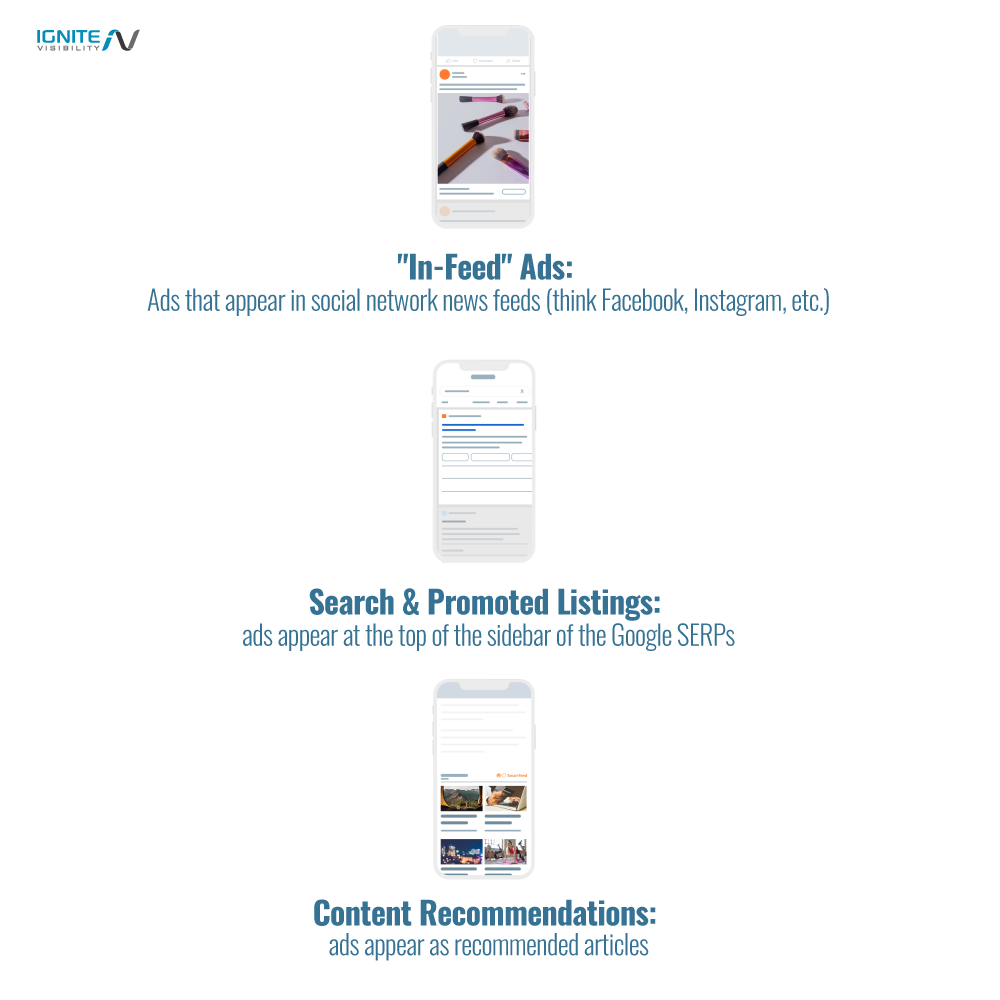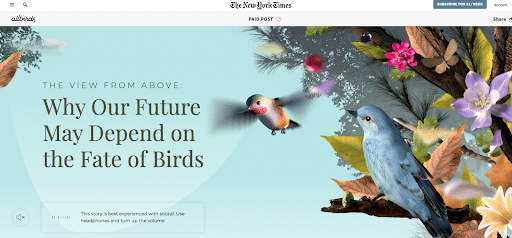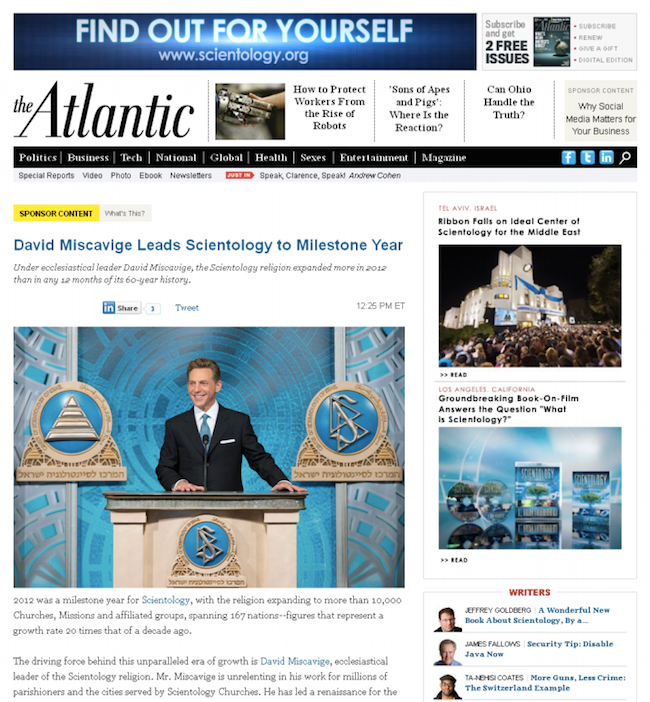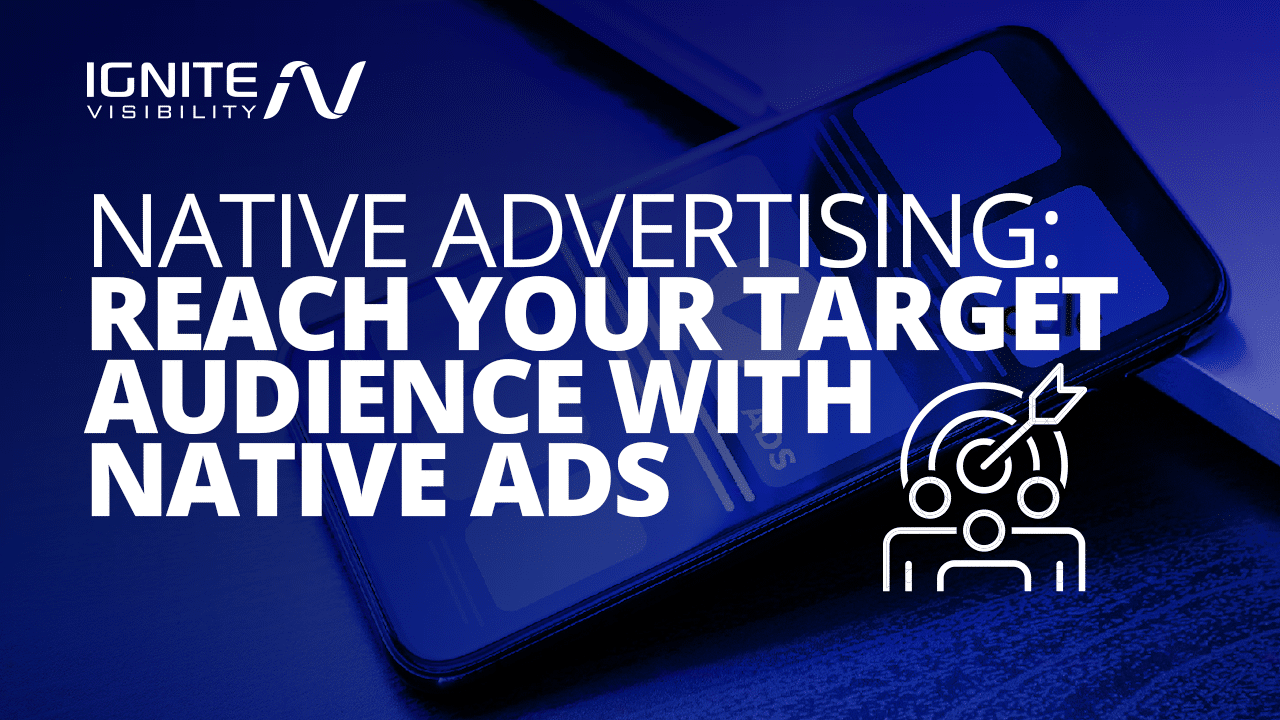
In This Blog, We’ll Answer:
- What is Native Advertising?
- Native Advertising Statistics
- How Does Native Advertising Work?
- How Can You Tell What a Native Ad Is?
- 10 Examples of Native Advertising
- 3 Examples of Ineffective Native Advertising
- Native Advertising FAQs
What is Native Advertising?
Native advertising is a form of paid advertising. But it functions differently than traditional paid advertising.
Native advertising uses written content and is essentially an ad that’s disguised as original content.
Like traditional PPC ads in the Google SERPs, they’re clearly labeled “ad,” and are still interspersed with other non-ad content in the results.
Native advertising takes the same principles as these other ads and inserts them into written content.
In a magazine, a native advertising example might appear as another article but is actually an advertisement. It fits seamlessly into the content that surrounds it, which is why it’s often mistaken for actual content.
Different Native Ad Platforms
Now that you know what native advertising is, let’s look at some of the different native advertising platforms out there that you can use.
Native advertisements are usually presented in one of three ways:
- In-Feed Ads: Ads that appear in social network news feeds (think Facebook, Instagram, etc.)
- Search & Promoted Listings: Ads appear at the top or sidebar of the Google SERPs
- Content Recommendations: Ads appear as recommended articles
Native Advertisements
Depending on what you’re looking for in the ideal setting for native content, the following are some of the popular platforms you can use for native advertising:
- Nativo — One platform worth considering for native ads is Nativo, which enables you to display in-feed and on-site content with the publisher’s branding. You can also launch video ads that feature scroll-to-play or click-to-play options, which is great for appealing to mobile users. It’s also very easy to use. One of the only downsides to this platform is a lack of filtering data by the campaign.
- OutBrain — Get plenty of tools to manage your native advertising campaigns with OutBrain, which is a programmatic native ad platform that allows you to plan, develop, and track your ad campaigns. One key advantage of this platform is that it exclusively works with publishers that get a minimum of a million views per month, meaning you can maximize your visibility with publishers on OutBrain. However, keep in mind that this platform doesn’t give you the kinds of customization options you’ll find with other services.
- Sharethrough — Get your ads on high-quality websites and mobile apps with Sharethrough, which provides superior integrations for advertisers and publishers alike to get the most from native content on premium sites and apps alike. One issue with this platform is a lack of segmentation for audiences, which can limit your targeting capabilities.
There are many platforms you can choose for native advertising based on your needs. Consider specific factors like targeting capabilities, budget, quality, media and content formats, and publisher networks when making your selection.
How is Native Advertising Different From Content Marketing? (and Sometimes Controversial)
What are native ads compared to content marketing?
The main difference between these two is that native advertising is a “pay to play” service.
Brands pay for the ability to put their content in places where they think their target audience will find it.
Content marketing focuses on owned media, rather than paying to place it somewhere.
Content marketing is not advertising, while native advertising very much is.
So, if it’s a format designed to look like non-promotional content, how can users tell it apart?
Generally, it will either contain markers like “sponsored post,” “promoted post,” or something similar. Or, it will have a small clickable icon that separates it from non-promotional content.
How Do SEO and Native Advertising Fit Together?
How do search engine optimization and native advertising fit together? Like this.
With content marketing generating more exposure for brands, the driving theory is that SEO is moving away from explicit link-building, and more towards a content marketing approach.
And because native ads mimic content, they’re likely to drive more exposure.
For small businesses with a strong SEO and social media base, native advertising would be well worth experimenting with.
I think of native advertising a bit like guest posting but without the outright benefit of links. Native ads are simply another place for you to get your content into the hands of the right audience.
Who Benefits from Native Advertising?
The main reason to use native ads is to reach audiences using some of the most relevant and high-quality content available on trusted platforms. Your ads will connect with people who are more likely to be interested in your offerings, mainly because the ad content will match the surrounding content.
The benefits of native advertising work for the advertisers and publishers who use them. Advertisers benefit by pushing highly relevant ads to potential customers on some of the best platforms they trust, encouraging more people to click through and engage with the brands using those ads.
At the same time, publishers benefit from a streamlined user experience that keeps people engaged with their content. Meanwhile, ads naturally appear within the content and can help publishers earn additional revenue.
Why is Native Advertising Effective?
The reason why native advertising has proven to be so effective is that they are usually better received by their target audiences.
Because they don’t “feel” like advertisements, people are more inclined to view them and consume their content.
Traditional ads are easy to ignore, as people are constantly exposed to marketing ads throughout the day. Because people don’t skim over native ads so easily, they allow brands a greater opportunity to get their message across.
In order to keep up with the changing digital landscape, brands are embracing content marketing and/or native advertising as the means for getting their marketing messages across.
Over time, consumers have learned how to “tune out” unwanted ads and marketing messages.
You can see the evidence of this in the growth of ad-blocking software, as well as subscription models (Spotify, Pandora, etc.) that allow consumers to pay a higher fee in order to disable advertisements.
The old way of forcing marketing messages is no longer as effective, leading many marketers to opt for native advertising instead.
Some Native Advertising Statistics
Here are some additional statistics highlighting the benefits of native advertising:
- People actually look at native ads 53% more often than traditional display ads.
- Native ads generate 18% more purchase intent.
- The native ad market is expected to increase to a whopping $402.33 billion by 2025.
- Mobile native ads account for over 84% of all mobile ad spend.
- 90% of the top publishers out there use native advertising.
- In-app native ads also see a 60% higher click-through rate compared to mobile web ads.
- 75% of consumers tend to trust content and recommendations appearing in native marketing, as it naturally integrates into the surrounding content.
- Native video advertising comprises 56% of all video ad spending.
- 70% of people are more likely to actually engage with a native ad over a traditional banner ad.
- Native ads can also increase brand lift 82% more than banner ads.
How Does Native Advertising Work?
First, a brand pays to place its content on native advertising platforms of its choosing.
Just like any other advertising venture, picking the correct platform is a crucial step.
This could be on a specific social media platform such as Facebook, Twitter, Instagram, or TikTok, or on a different platform like Google or a third-party site.
Next, the content is created to mimic the look and feel of the content that surrounds it on the platform. What brands are actually paying for is the ability to “rent” the platform for their own distribution.
Once the content’s approved, it’s tagged with a “warning” of sorts that may say something like “Advertisement” or “Paid Advertisement.”
This creates some transparency within the native advertising platform and the user, so they know ahead of time that the content they’re looking at paid to be there.
So, what are native ads more specifically, and how does each type work? Let’s look a little closer at how these ads work based on the different types:
In-Feed Ads
These ads appear in line with other types of content in a feed, such as a feed on a news website. These typically take the form of “sponsored posts.”
An example of an in-feed ad could look like this PayPal ad on Entrepreneur’s website. It fits naturally within the content and doesn’t look as much like an ad as it does a thumbnail for another article.

Example of In-Feed Ads on Entrepreneur
Search & Promoted Listings
Advertisers can also get ads in search results through search and promoted listing ads. These ads show up in search results and often resemble typical organic results, or they could show up in images above or beside other content.
For example, here’s what comes up when you search “boots for sale.”
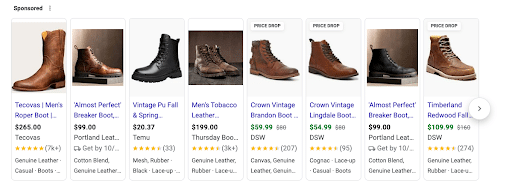
Search and Promoted Listings for ” Boots for Sale”
Content Recommendations
Another form of native advertising involves content recommendations. These ads normally appear at the bottom or side of other content, recommending people to view other related content. For instance, an article might link you to similar recommended content in a “Related Topics” section after reading. You could also see “Recommended for you,” “Recommended Stories,” or other formats.
How Can You Tell It’s Native Advertising?
For the trained eye, it’s easy to spot an ad.
- Do the words “Suggested Post” or “Recommended For You” appear anywhere on the content?
- Check the upper right-hand corner of the content block. Is there a small icon with a question mark and an X?
- Is the word “sponsored” on the post?
- Does it have a sponsorship credit anywhere on the block — i.e. “Sponsored by Ignite Visibility”?
- Is it recommended or suggested?
If so, you’re probably looking at native content.
How Does Native Advertising Look On Mobile?
Like any other type of digital marketing, you should ensure your native ads are mobile-friendly.
Native ads take on the look and feel of a mobile app interface on a mobile device.
Using native direct ads through an app is a win-win situation for all parties involved.
Developers don’t mind them since they appear as part of their app. Unlike traditional advertising mediums, native advertisements offer a minimal perceived disruption to their user.
Users enjoy them for the same reason: they don’t like ads. But they do like content.
Take a look at your Twitter feed. As you’re scrolling through, you’ll see tweets from the people you follow. You chose those people because you’re interested in their content and what they have to say. But targeted native ads are positioned throughout those Tweets. Since your brain thinks it’s reading through Tweets from people you’ve already selected, your mind just continues to read over the suggested content.
Native advertisements can also adjust their look whenever an app’s interface upgrades or changes. If an app updates its look, it’s important for the designers of the advertisement to do the same. By keeping up with the selected mobile application, native marketing designers keep their content fresh and constantly popping up in front of the right consumer.
Native Advertising Examples
What are native ads that have worked in the past? Here are a few native advertising examples that you may have seen before.
#1 — Allbirds
One example of effective native advertising is from shoe manufacturer Allbirds, which created a colorful animated post for The New York Times as a paid post.
The post focuses on the risk of endangerment that different birds face because of climate change and how Allbirds is working to mitigate that risk. Specifically, the article discusses the effects various bird species have on the environment and how Allbirds works to produce shoes using sustainable, eco-friendly processes and materials.
#2 — Forbes
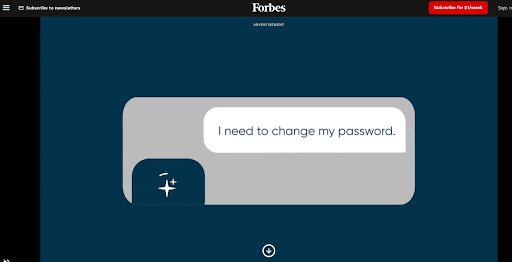
Forbes Native Ad Example
One notable example of a site that uses native ads frequently is Forbes, which includes a variety of ads. For example, the ad in the image above fills the screen when you load the page, and it advertises a generative AI program that many professionals (and active readers of Forbes) would likely find helpful.
Other ads come in the form of informational ads that educate and inform readers while advertising a particular brand.
#3 — Buzzfeed
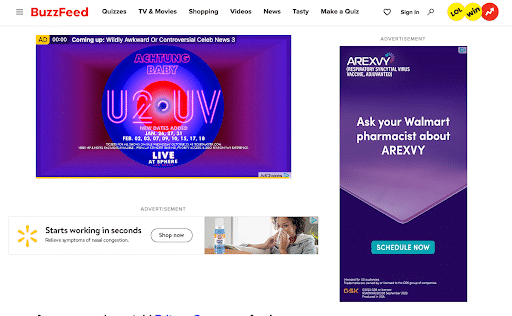
Walmart Ad on Buzzfeed
Buzzfeed is a great example of a publisher that’s all about native ads. The platform, as you can see in the image above, has many spaces for different brands to advertise.
First, there’s the video ad that plays before the actual video at the top of the article. Right below that is a small banner ad for Walmart, and to the right is another ad. While the last two aren’t necessarily native, if you keep scrolling to read the article, you’ll come across other naturally incorporated video ads that blend right in with the surrounding content.
#4 — Facebook
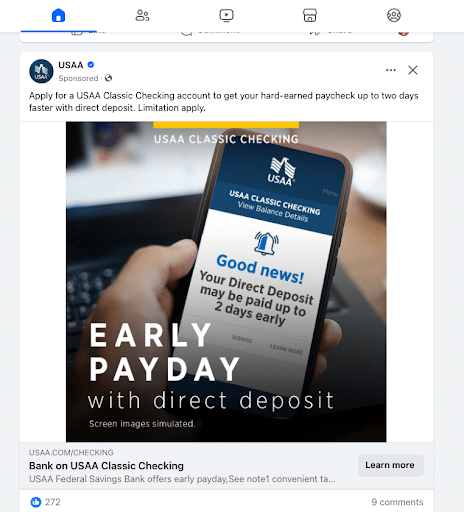
Native In-Feed Ads on Facebook
Facebook remains a champion of native in-feed ads. As you scroll down your feed on the website or the app, there are many sponsored ads that look just like regular posts, making people less likely to zip past them when scrolling.
#5 — Washington Post & Mercedes-Benz
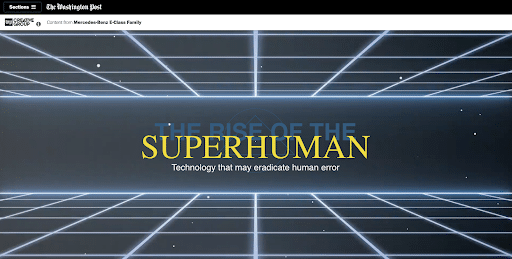
Native Ad Campaign
This is another example of a big visual post like Allbird above, only this is a collaboration between The Washington Post and Mercedes-Benz.
This native ad campaign titled The Rise of the Superhuman goes into the many different technologies that will eliminate the risk of human error. As you scroll down, you get info about everything from robotic exoskeletons to Mercedes-Benz’s latest E-Class line of vehicles that include a variety of safety features.
#6 — Google Sponsored Ads
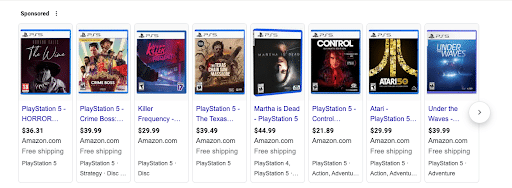
Playstation 5 Ad
Google pushes relevant ads when you conduct a search for specific products.
In this example, searching “Playstation 5 games” brings up a list of games for sale on Amazon. Seeing as it’s October at the time of writing this, some horror games automatically display to fit the theme of Halloween.
#7 — Instagram Carousel Ads

Instagram Carousel Ad
Scrolling through Instagram, you may find carousel ads that appear in your feed, like this one from Temu.
These ads include multiple images or slides that you can go through to look at different products. They also include a convenient “Shop Now” button if you want to purchase a product quickly.
#8 — Croatian Lottery
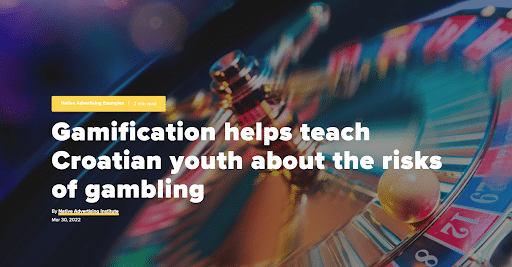
Winner – Native Advertising Awards
Croatian Lottery actually won the Native Advertising Awards in 2022 with this campaign, which includes native ads discussing how gambling has negatively impacted young people’s lives in Croatia.
It details how gamification can help inform Croatian youth about the potential dangers of gambling while still enjoying the game. The campaign itself used gamification to keep people engaged once they landed on the microsite dedicated to the campaign.
#9 — Michelin
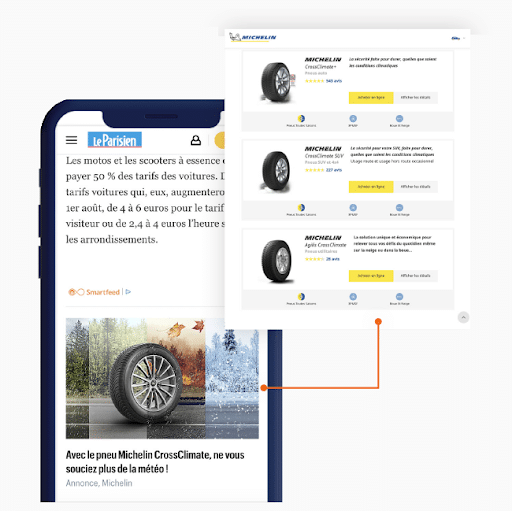
Tire manufacturer Michelin launched a campaign that promoted the brand’s winter tire products. The ads reached relevant audiences through relevant publishers, connecting with people who would most likely want to buy winter-proof tires ahead of winter.
The campaign was a success, leading people to stay on Michelin’s websites for longer periods while minimizing the company’s cost-per-visitor.
#10 — Walpole
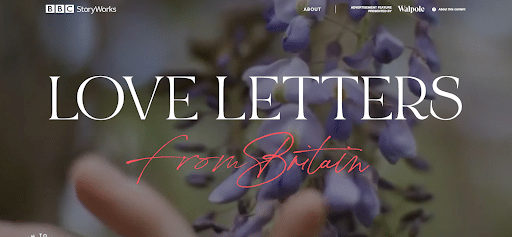
Example of Native Ads
One last example is from the UK brand Walpole, which advertises itself as the official sector body for UK luxury. The company’s “Love Letters from Britain” campaign, as featured on BBC StoryWorks, explores nine different stories about all types of luxury brands and products, including everything from luxury vehicles to fashion.
This campaign was particularly good for building brand awareness, whereas many native ads tend to be geared more toward making a sale.
What is an Example of Ineffective Native Advertising?
Let’s look at a few more examples, ones that aren’t so successful.
#1 — The Church of Scientology
Many widely criticized this notorious ad from the Church of Scientology for promoting the church while appearing to look like a normal piece of native content published by The Atlantic.
This highlights an important criticism of native advertising: that many use it as a sneaky way to prompt your agenda.
The Atlantic took a lot of heat for this native ad and eventually took it down altogether.
The lesson learned here? Make sure your ad matches the platform it appears on. The Atlantic suffered because it ran an ad preaching a subject its readers didn’t care about–and because it blended into the site’s usual content, it was easy to think the publication was simply running an article to support Scientology, rather than hosting an ad.
As mentioned earlier, the first step in successful native advertising is choosing the proper channel. Make sure you do so wisely.
#2 — “King of the Nerds”
Another notoriously failed native marketing campaign is the “King of the Nerds”-sponsored Gawker article, “How to Transform into a Total Nerd-Babe.” It was tone-deaf and did not come across well to its audiences.
Not only did many argue that it was offensive and vapid, but it was also difficult to determine who even sponsored the campaign, making it overall ineffective. The ad came from PBS TV reality show “King of the Nerds,” but it looked like it was just another Gawker article without any clear distinction.
The problems seen with this campaign led Gawker to carefully choose its sponsored content and effectively distinguish it as “sponsored” by a specific entity.
#3 — Weather Underground
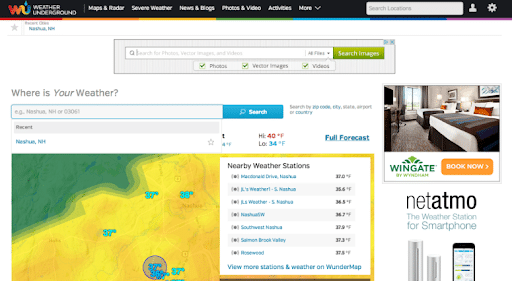
Weather Underground is another example of a native ad failure, one that entailed deceiving audiences. In an article for McDougall Interactive, Bob Rustici detailed how he had visited the Weather Underground website to check the local weather, only to enter his location into a search bar, which was actually part of an ad.
As the image details, you can see two search bars, one at the top of the page and one below. The top happened to be an ad for an image site, but you wouldn’t know it unless you looked closely at the buttons and checkboxes.
After entering the location, the ad redirected Rustici to the advertiser’s site, which led to understandable confusion and frustration with both the publisher and the advertiser.
In short, this ad shows how deceiving your audiences with your ads could merely hurt your reputation.
FAQs on Native Advertising:
1. Is native advertising more effective than content marketing?
Short answer: no.
While it certainly has its advantages, it’s not meant to replace content marketing. Native advertising is typically a one-time thing; it’s a great way to introduce yourself and your business to an audience and to give them a reason to dig deeper into what it is you offer.
Content marketing, on the other hand, is all about the long haul. It’s meant to solidify a brand’s reputation and create an ongoing relationship with customers through different media and channels (which could include native advertising.)
2. Are there different native advertising formats?
Yes, there are different formats, including:
- In-feed ads: promote sponsored content in natural feeds
- Recommendation widgets: these appear at the end of articles in the “recommended for you” or “you may also like” sections
- Promoted listings: used to promote sponsored products and appear with other listings
- Paid search ads: similar to promoted listings, but appear at the top of search results
3. Is native advertising affected by AdBlocks?
One advantage of native ads is that they rarely get caught in adblocking software. This, of course, is because they’re served along with regular content.
Most ads that get caught by ad blocks are ones that are flagged as overly annoying or intrusive. However, in February 2018, Google blocked certain ads in the Chrome browser, including some native ads.
4. How do you measure native advertising?
Just like other digital marketing channels, you can measure native advertising’s effectiveness in terms of data. You can measure impressions, click-through rate, clicks, etc. There are tools created specifically to track your native ad analytics, such as SpyOver and Parse.ly.
5. Can a user tell if they’re clicking on a native ad?
Not necessarily. In fact, studies have shown that consumers often identify native ads as articles. That same study revealed some other interesting facts about native ads:
- Consumers often have a difficult time identifying the brand associated with a piece of native advertising (but it varies)
- Consumers who read native ads that they identified as high quality reported a significantly higher level of trust for the sponsoring brand.
- 48 percent have felt deceived upon realizing a piece of content was sponsored by a brand
6. Why should you use native advertising?
There are four stages of a sales funnel: attract, convert, close, and delight.
The attract stage is when people are first introduced to your content. While this might seem like the appropriate place to utilize the benefits of native advertising, it actually isn’t.
The proper time to execute native ads is somewhere between the convert and close stages. You want to target people who are already familiar with your brand and who may have already consumed your products/services in the past.
7. How can I start using native advertising?
Now that you understand the theory behind native advertising, you probably want to put this new knowledge into practice.
If you have already begun a strong content marketing campaign, congratulations! You’re already on your way to native advertising.
The next step is to take these engaging stories that you have created for your brand and pay native advertising platforms to promote them. Research the best native ad vendors in your industry and collect pricing information and offers from them. Once you decide on the right platform to reach your target audience, you can utilize your existing native content to run a profitable native advertising campaign.
8. What trends are shaping the future of native advertising?
You might want to know what kind of digital ad trend you can use to supercharge your native ad campaigns.
A few key trends to consider include:
- More personalization that uses high-quality data to deliver the most relevant content to the right audiences
- A better blend of content and ads to make the user experience even more seamless when encountering native advertising
- Increased transparency allows for more ethical ads that build trust among users.
9. Can native advertising be used for any type of business or industry?
Because it’s a more narrative-focused form of advertising using native content, the industries that benefit most from this type of advertising are those with a focus on storytelling and visual elements. However, it can work for any industry with the right approach.
10. How do native ads perform in comparison to traditional display ads?
Unlike traditional ads, native ads are compatible with their corresponding platforms’ design and content. As a result, they’re more likely to blend in with surrounding content and drive more engagement. They also appear right in the middle of content as opposed to the periphery, grabbing people’s attention more effectively.
11. Do native ads require continuous texting and optimization?
As with any other type of ad, you should continually test and optimize your native ad campaigns. Based on the results you want and the goals you have set, you can take steps to perfect your campaigns and drive even better results.
Consider using methods like A/B testing, which involves running two instances of the same ad using a different element, such as a visual or message. You can then determine the benefits of native advertising with one version or the other.
12. How does native advertising uphold or challenge ethical advertising standards?
Native marketing can remain ethical with the right approach, but it’s important to remember that native ads often look much like the content around them.
Because of their stealthier nature, you should ensure your native content is ethical by labeling it as “sponsored” or otherwise indicating that it is, in fact, an ad.
Native Advertising in the Future
Native advertising is exploding in popularity.
I think that most brands can benefit from using native advertising as a tactic, but it shouldn’t inform your whole online marketing strategy. Anything that allows you to get your content in front of the right audience is something you should embrace.
It will be interesting to see how native advertising influences the way we consume content in the future.
Want to thrive with a native ad campaign? The team at Ignite Visibility is here to help. We offer some of the most reliable ad services available to help you develop campaigns using a combination of native and other ad forms.
With the help of our solutions, you’ll benefit from:
- Increased ad relevance, which leads to more engagement and higher purchase intent
- Better brand awareness and credibility as your ads appear in high-quality content from leading publishers
- Improved cost-effectiveness with high-performing native ads
Want to discover what Ignite Visibility can do for you with native ads and more? Reach out to us today to get started on your next campaign.
